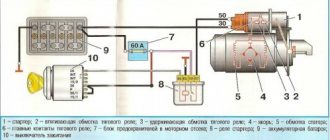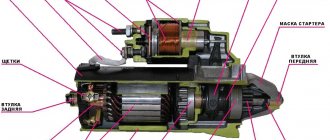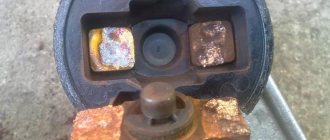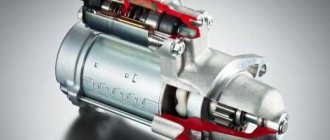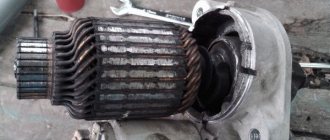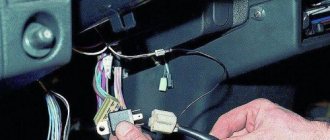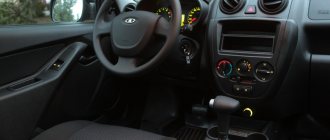The design and principle of operation of the VAZ 2110 starter
The starter of any car is simply a DC traction motor. No more, no less. Everything else is simple mechanics. The only hitch in the design of the VAZ 2110 starter may be the retractor relay, and even then, if you are dealing with it for the first time. There are absolutely no difficulties in either repairing or replacing starter elements. The main thing is to know the principle of operation and then you can find any breakdown in no time.
Briefly about the starter design. The picture shows the VAZ starter, as well as all the structural elements, which we see no point in listing. The design of the starter has a lot of minor parts, but there are also those that, if they are faulty, the starter will not even think about rotating the flywheel. In principle, there are only two main reasons for starter failure - mechanical and electrical failure.
Video: Starter Clicks But Doesn’t Spin VAZ 2110
There are also budget freelance models on the car market; they can be purchased for 3 thousand rubles. Whatever the starter is, this must be guaranteed. Of course, the imported version performs better, but the standard unit is excellent value for money.
Source
Basic starter failures
Electrical troubles can easily include:
- lack of contact at the starter terminals or the ignition switch contact group;
- starter relay failure;
- failure of the electromagnetic retractor relay;
- break in the rotor winding;
- stator winding break;
- overheating and burnout, short circuit of windings;
- violation of the integrity of the wiring of the supply or control circuits.
Mechanical failures of the starter are even simpler and can be calculated in no time. There are quite a few of them, but we will list the main ones:
- wear of the Bendix gear, which meshes with the crankshaft flywheel;
- wear of starter rotor bushings or bearings, armature misalignment, rubbing and possible short circuit;
- damage to the bendix mechanism;
- wear or failure of the planetary gears of the gearbox;
- mechanical wear of brushes;
- burning of the contact plate of the solenoid relay.
Auto-assistance
The starter is one of the most important parts of the engine starting system. With its help, the shaft spins up to the frequency at which the engine starts.
The starter is combined into a single functional circuit with the battery, ignition switch and generator. Failures in this system can lead to engine malfunction. The rich experience of the global automotive industry allows us to identify the following most important types of violations in the operation of the starter.
Firstly, the reason that the starter does not work may be a discharged battery . At the same time, the portable test lamp used to check the battery charge lights up with a dim, weak light. However, during monitoring, the lamp emission may be sufficient, indicating that the battery is fully charged. In this case, it is necessary to check the serviceability of the connection of the battery with the rest of the circuit of devices. Wire terminals that have undergone oxidation, as well as plates, may fail due to sulfation, short circuit or complete separation.
Another reason for the starter to malfunction may be a malfunction in the ignition switch - traction relay . There are several options here: either the ignition switch has failed (no current supply), or the traction relay is faulty (broken disk), or there is no contact between the traction relay and the ignition switch.
In cases where there is no crankshaft rotation at all, the cause should be sought in the commutator or starter brushes . The collector may become oxidized or contaminated, which will inevitably lead to early wear. Commutator brushes can also become dirty or worn out over time. Often, upon inspection, a defect in the flywheel teeth is discovered, as a result of which the gear does not contact them and rotation is not transmitted to the flywheel.
A bigger problem may be residual starter activity after the engine starts running. The reason lies in the contacts of the ignition switch or in the starter itself (wrong position). The armature shaft may also be faulty: its surface may be bent or covered with plaque formed due to mechanical wear of the drive sleeve bearings.
When starting the engine, there may be excessive noise produced by the starter. The problem here is a weak starter, worn bearings, damaged gear teeth or flywheel. Thus, due to a significant number of types of faults, malfunctions in the starter should be eliminated in the conditions of specialized maintenance stations.
Share this article with your friends:
Subtleties and tricks when repairing a starter
We will not consider childhood illnesses - the battery is dead, the key will not turn, in a well-maintained car everything always turns and the battery is in order. Another thing is the subtleties that can lead to the fact that the VAZ 2110’s starter does not turn or turns, but not as expected. And here the problem may not be in the starter at all, but in the battery terminals.
It's easy to check. Very often the terminals oxidize, especially in damp weather and winter, when the amount of condensation under the hood is large. In winter, this feature may well lead to the fact that the contact between the battery terminals is so loose that there is simply not enough current to rotate the starter. It is lost among the white or greenish coating. It is enough to clean the terminals and lubricate them with a special preservative lubricant with conductive properties, and the starter will turn like new.
Electrical breakdowns
The next fairly common problem is the failure of the starter relay or fuse. This is the case when the starter refuses to respond to turning the key at all. Everything is simple here - replacing the fuse according to the diagram or replacing the relay will solve the problem.
There is another floating fault, also associated with a contact, but this time with the contact of the negative wire, which goes from the battery terminal to the car body. This happens very often and the culprit may be either corrosion or debris that prevents good contact. In this case, it is enough to clean the place where the wire is attached, the terminal, and everything will work. A similar problem is a broken wire that connects the body and engine ground. It’s even easier to check this - using any wire of a suitable cross-section, you need to connect the starter ground to a reliable ground on the engine. If the starter works, that's all.
Starter malfunctions
A characteristic sign: the starter turns hard, especially in winter. Therefore, many car owners change brushes, wear of which is a common occurrence. It has been proven that these elements are the least reliable. It is difficult to find an original spare part for your original device. But there are many analogues. For example, the Taiwanese brush assembly from Unipoint SH3503. Installed on various vehicles, including the Chinese Lifan. Approximate price: 400 rubles.
Other typical problems:
- damage to the overrunning clutch - clanging noise when starting the VAZ-21124 engine;
- cracking of the ring gear of the planetary gearbox;
- defects in the collector lamellas.
Starter problems are caused by holding the ignition key for a long time in start mode. Some owners, due to ignorance or other reasons, subject the device to colossal and incredible loads.
Starter repair and disassembly
If the starter, or more precisely, the solenoid relay, clicks, but the starter does not turn, the contact plate on the relay is burnt. Here it is necessary to completely dismantle the starter and remove carbon deposits from the plate using sandpaper. There are also cases of brushes hanging or wearing out prematurely due to dirt that has penetrated into the starter. In this case, it is undesirable to delay repairs, because you can lose the anchor, and this is an expensive pleasure.
Other reasons can only be determined by dismantling the starter, complete disassembly and rejection of failed parts. The same applies to the closed windings of the armature and stator. Take care of the starter and successful starts to everyone, even in the most severe frost!
Why doesn't the starter turn?
What to do if the car does not start, but the starter
does not respond, clicks, but does not turn and is missing? Why can't I start the engine when I turn the key, what are the causes of the problem? One of the main reasons why the device does not turn off is insufficient power of the mechanism. This may indicate a lack of required mains voltage due to a low battery. If the battery is completely discharged or disconnected, the mechanism will not show any signs of life.
READ Door Handle Not Working VAZ 2109
Auto starter
If the starter
does not press when the key is on, the engine does not start, first you need to check the quality of the battery cable connection. It is possible that the battery wires are not disconnected from the terminals, but are simply oxidized.
If so, don't panic, you just need to do the following:
- First you need to turn off the battery and disconnect the terminals from it;
- Use sandpaper to sand the inside of the battery terminals and also clean the battery contacts;
- Then you need to check how charged the battery is - use a charger;
- Next, it is necessary to diagnose the integrity of the cables, namely the wires intended to power the starter;
- After completing these steps, the battery terminals should be securely fastened so that they do not become disconnected later.
Often one of the main reasons why the starter does not turn on when pressed is a completely discharged battery. If the key does not start the engine, the mechanism may react and show some signs of life. In particular, when you start turning the key, you will be able to hear this characteristic and powerful click, otherwise the mechanism will be able to crank the internal combustion engine, but only once. To solve a problem with a gasoline or diesel engine, try charging the battery - it may then begin to supply power.
Mechanism components
Every car enthusiast knows why a car needs a generator - this device allows you to transfer voltage to the on-board network and battery.
This operation provides additional charge to the battery, but you should not rely solely on the generator, as it will not be able to fully charge the battery:
- The battery must be at rest while charging;
- When the generator is running, additional load is placed on the battery;
- While driving, the generator charges the battery in low mode;
- In any case, running the generator will only partially restore the battery level used to start the engine.
Accordingly, if the battery is completely discharged, you should not count on charging it from the generator. The best option is to charge the device with a charger. As practice shows, in principle the starter does not work, it clicks, but does not turn on and the engine does not start due to the battery. However, in some cases, the problem may be due to a faulty engine starting system. At the same time, the starter itself may make sounds that are not characteristic of its operation.
READ Chevrolet Cruze Cigarette Lighter Not Working
Oxidation of battery contacts
If this is the case and this is the reason the car won't start, you will have to spend more time finding it.
Below is a list of the main faults that interfere with the operation of a diesel or gasoline engine:
- The mechanism may be turned off or periodically turn off due to a short circuit in the network. As a result, one of the windings may burn out, so the mechanism may even smoke. In addition, a characteristic sign of this failure is an unpleasant burning odor in the wiring.
- Electromagnetic relay malfunction. This may cause the bendix to malfunction. The mechanism itself refuses contact with the power unit.
- Bendix's teeth are damaged; therefore, this component cannot work and start the device due to lack of contacts.
- There has been a breakdown in the electrical circuit directly to the starter. One of the wires may burn out or one of the contacts may fail (the author of the video is Valera Nazipov).
